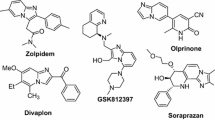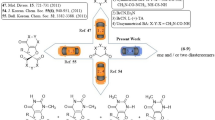Abstract
The applications of \(N{,}N{,}N^{\prime }{,}N^{\prime }\)-tetrabromobenzene-1,3-disulfonamide [TBBDA], poly(N-bromo-N-ethyl-benzene-1,3-disulfonamide) [PBBS], \(N{,}N{,}N^\prime {,}N^\prime \)-tetrachlorobenzene-1,3-disulfonamide [TCBDA], and poly(N-chloro-N-ethyl-benzene-1,3-disulfonamide) [PCBS] as novel reagents for the preparation of spirocyclopropylbarbiturates from 2-arylidenemalononitriles and barbituric acids are described. In addition, an effective and simple domino procedure for the synthesis of 3-substituted-1,1,2,2-tetracyanocyclopropanes from carbonyl compounds and malononitrile in a one-pot manner is reported. These reactions involve Michael addition, halogenation, and intramolecular ring-closing (MHIRC) reaction sequences.
Graphical Abstract
We have developed an efficient procedure for the synthesis of spirocyclopropylbarbiturates and 3-substituted-1,1,2,2-tetracyanocyclopropanes using TBBDA, PBBS, TCBDA, and PCBS as new reagents





Similar content being viewed by others
References
Maquoi E, Sounni NE, Devy L, Olivier F, Frankenne F, Krell HW, Grams F, Foidart JM, Noel A (2004) Anti-Invasive, antitumoral, and antiangiogenic efficacy of a pyrimidine-2,4,6-trione derivative, an orally active and selective matrix metalloproteinases inhibitor. Clin Cancer Res 10:4038–4047. doi:10.1158/1078-0432.CCR-04-0125
Johns MW (1975) Sleep and hypnotic drugs. Drugs 9:448–478. doi:10.2165/00003495-197509060-00004
Naguib FNM, Levesque DL, Wang EC, Panzica RP, El Kouni MH (1993) 5-Benzylbarbituric acid derivatives, potent and specific inhibitors of uridine phosphorylase. Biochem Pharmacol 46:1273–1283. doi:10.1016/0006-2952(93)90477-E
Fraser W, Suckling CJ, Wood HCS (1990) Latent inhibitors. Part 7: inhibition of oihydro-orotate dehydrogenase by spirocyclopropanobarbiturates. J Chem Soc Perkin Trans 1:3137–3144. doi:10.1039/P19900003137
Renard A, Lhomme J, Kotera M (2002) Synthesis and properties of spiro nucleosides containing the barbituric acid moiety. J Org Chem 67:1302–1307. doi:10.1021/jo016194y
Muthusamy S, Gunanathan C (2003) Reactions of cyclic diazoamides: convenient synthesis of dispirocyclic cyclopropane systems. Synlett 2003:1599–1602. doi:10.1055/s-2003-40996
Krysiak J, Kato T, Gornitzka H, Baceiredo A, Mikolajczyk M, Bertrand G (2001) The first asymmetric cyclopropanation reactions involving a stable carbene. J Org Chem 66:8240–8242. doi:10.1021/jo010586n
Singh VK, DattaGupta A, Sekar G (1997) Catalytic enantioselective cyclopropanation of olefins using carbenoid chemistry. Synthesis 1997:137–149. doi:10.1055/s-1997-1172
Muller P, Allenbach Y, Robert E (2003) Rhodium(II)-catalyzed olefin cyclopropanation with the phenyliodonium ylide derived from Meldrum’s acid. Tetrahedron Asymmetry 14:779–785. doi:10.1016/S0957-4166(03)00029-6
Xin X, Zhang Q, Liang Y, Zhanga R, Dong D (2014) Tandem halogenation/Michael-initiated ringclosing reaction of \(\alpha \), \(\beta \)-unsaturated nitriles and activated methylene compounds: one-pot diastereoselective synthesis of functionalized cyclopropanes. Org Biomol Chem 12:2427–2435. doi:10.1039/c4ob00087k
Little RD, Dawson JR (1980) MIRC (Michael Initiated Ring Closure) reactions formation of three; five, six and seven membered rings. Tetrahedron Lett 21:2609–2612. doi:10.1016/S0040-4039(00)92818-1
Kawai D, Kawasumi K, Miyahara T, Hirashita T, Araki S (2008) Cyclopropanation mediated by lithium iodide of electron-deficient alkenes with activated dibromomethylene compounds. Synlett 2008:2977–2980. doi:10.1055/s-0028-1087341
Elinson MN, Vereshchagin AN, Stepanov NO, Zaimovskaya TA, Merkulova VM, Nikishin GI (2010) The first example of the cascade assembly of a spirocyclopropane structure: direct transformation of benzylidenemalononitriles and \(N{,}N^{\prime }\)-dialkylbarbituric acids into substituted 2-aryl-4,6,8-trioxo-5,7-diazaspiro[2.5]octane-1,1-dicarbonitriles. Tetrahedron Lett 51:428–431. doi:10.1016/j.tetlet.2009.11.065
Dorofeeva EO, Elinson MN, Vereshchagin AN, Stepanov NO, Bushmarinov IS, Belyakov PA, Sokolova OO, Nikishin GI (2012) Electrocatalysis in MIRC reaction strategy: facile stereoselective approach to medicinally relevant spirocyclopropylbarbiturates from barbituric acids and activated olefins. RSC Adv 2:4444–4452. doi:10.1039/c2ra20078c
Vereshchagin AN, Elinson MN, Dorofeeva EO, Stepanov NO, Zaimovskaya TA, Nikishin GI (2013) Electrocatalytic and chemical methods in MHIRC reactions: the first example of the multicomponent assembly of medicinally relevant spirocyclopropylbarbiturates from three different molecules. Tetrahedron 69:1945–1952. doi:10.1016/j.tet.2012.12.029
Wideqvist S (1945) 2,2-Dimethyl-1,1,3,3-tetracyanocyclopropane. Arkiv for Kemi 20B:8–14
Hart H, Kim YC (1966) A new synthesis of tetracyanocyclopropanes. J Org Chem 31:2784–2789. doi:10.1021/jo01347a013
Kim YC, Hart H (1969) Synthesis and NMR spectra of 3-aryl-1,1,2,2-tetracyanocyclopropanes. Tetrahedron 25:3869–3877. doi:10.1016/S0040-4020(01)82918-5
Elinson MN, Feducovich SK, Stepanov NO, Vereshchagin AN, Nikishin GI (2008) A new strategy of the chemical route to the cyclopropane structure: direct transformation of benzylidenemalononitriles and malononitrile into 1,1,2,2-tetracyanocyclopropanes. Tetrahedron 64:708–713. doi:10.1016/j.tet.2007.11.027
Vereshchagin AN, Elinson MN, Stepanov NO, Nikishin GI (2009) One-pot cascade assembling of 3-substituted tetracyanocyclopropanes from alkylidenemalononitriles and malononitrile by the only bromine direct action. Mendeleev Commun 19:324–325. doi:10.1016/j.mencom.2009.11.010
Elinson MN, Vereshchagin AN, Stepanov NO, Ilovaisky AI, Vorontsov AY, Nikishin GI (2009) A new type of cascade reaction: direct conversion of carbonyl compounds and malononitrile into substituted tetracyanocyclopropanes. Tetrahedron 65:6057–6062. doi:10.1016/j.tet.2009.05.062
Vereshchagin AN, Elinson MN, Stepanov NO, Nikishin GI (2011) New way to substitute tetracyanocyclopropanes: one-pot cascade assembling of carbonyls and malononitrile by the only bromine direct action. ISRN Org Chem ID 469453:1–5. doi:10.5402/2011/469453
Noroozi Pesyan N, Kimia MA, Jalilzadeha M, Sahin E (2013) A new, fast and easy strategy for one-pot synthesis of full substituted cyclopropanes: direct transformation of aldehydes to 3-aryl-1,1,2,2-tetracyanocyclopropanes. J Chin Chem Soc 60:35–44. doi:10.1002/jccs.201200189
Elinson MN, Feducovich SK, Lizunova TL, Nikishin GI (2000) Electrochemical transformation of malononitrile and carbonyl compounds into functionally substituted cyclopropanes: electrocatalytic variant of the Wideqvist reaction. Tetrahedron 56:3063–3069. doi:10.1016/S0040-4020(00)00195-2
Veisi H, Ghorbani-Vaghei R (2010) Recent progress in the application of \(N\)-halo reagents in the synthesis of heterocyclic compounds. Tetrahedron 66:7445–7463. doi:10.1016/j.tet.2010.07.015
Koval IV (2002) \(N\)-Halo reagents. \(N\)-Halosuccinimides in organic synthesis and in chemistry of natural compounds. Russ J Org Chem 38:301–337. doi:10.1023/A:1016390721218
Ghorbani-Vaghei R, Jalili H (2005) Mild and regioselective bromination of aromatic compounds with \(N{,}N{,}N^\prime {,}N^\prime \)-tetrabromobenzene-1,3-disulfonamide and Poly(\(N{,}N^{\prime }\)-dibromo-\(N\)-ethyl-benzene-1,3-disulfonamide). Synthesis 7:1099–1102. doi:10.1055/s-2005-861851
Ghorbani-Vaghei R, Maghbooli Y, Mahmoodi J, Shahriari A (2015) Poly(\(N{,}N^{\prime }\)-dibromo-\(N\)-ethyl-benzene-1,3-disulfonamide) and \(N{,}N{,}N^\prime {,}N^\prime \)-tetrabromobenzene-1,3-disulfonamide as new efficient reagents for one-pot synthesis of furano and pyrano pyrimidinones (thiones). RSC Adv 5:74336–7434110. doi:10.1039/c5ra16646b
Ghorbani-Vaghei R, Salimi Z, Malaekehpoor SM, Eslami F, Noori S (2014) One-pot synthesis of new derivatives of pyran using \(N\)-halosulfonamide. RSC Adv 4:33582–33586. doi:10.1039/c4ra04929b
Ghorbani-Vaghei R, Shahriari A, Salimi Z, Hajinazari S (2015) Solvent-free synthesis of triazines using \(N\)-halosulfonamides. RSC Adv 5:3665–3669. doi:10.1039/c4ra10892b
Arora R, Shandil A, Deep Kumar Jain A (2011) Synthesis and characterization of some barbituric acid derivatives-5-[(3\(^\prime \)-chloro-4\(^\prime \)-substituted phenyl-2\(^\prime \)-oxo-azetidin-1\(^\prime \)-yl) amino] barbituric acid. IJRPBS 2:1210–1214
Hartman WW, Sheppard OE (1943) Alloxan monohydrate. Org Syn 23:3–5. doi:10.15227/orgsyn.023.0003
Seeliger F, Berger STA, Remennikov GY, Polborn K, Mayr H (2007) Electrophilicity of 5-benzylidene-1,3-dimethylbarbituric and thiobarbituric acids. J Org Chem 72:9170–9180. doi:10.1021/jo071273g
Acknowledgments
We acknowledge with thanks the financial support received from Bu-Ali Sina University, Center of Excellence and Development of Chemical Methods (CEDCM).
Author information
Authors and Affiliations
Corresponding author
Electronic supplementary material
Below is the link to the electronic supplementary material.
Rights and permissions
About this article
Cite this article
Ghorbani-Vaghei, R., Maghbooli, Y., Shahriari, A. et al. Facile and efficient approach for the synthesis of spirocyclopropylbarbiturates and 3-substituted-1,1,2,2-tetracyanocyclopropanes using N-halosulfonamides. Mol Divers 20, 907–917 (2016). https://doi.org/10.1007/s11030-016-9682-y
Received:
Accepted:
Published:
Issue Date:
DOI: https://doi.org/10.1007/s11030-016-9682-y




